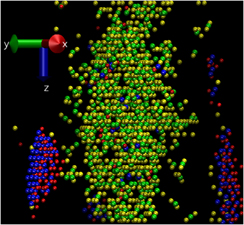Crossref Citations
This article has been cited by the following publications. This list is generated based on data provided by
Crossref.
Agulló‐López, F.
Climent‐Font, A.
Muñoz‐Martin, A.
and
Zucchiatti, A.
2016.
Alternative approaches to electronic damage by ion‐beam irradiation: Exciton models.
physica status solidi (a),
Vol. 213,
Issue. 11,
p.
2960.
Costantini, Jean-Marc
Miro, Sandrine
Gutierrez, Gaëlle
Yasuda, Kazuhiro
Takaki, Seiya
Ishikawa, Norito
and
Toulemonde, Marcel
2017.
Raman spectroscopy study of damage induced in cerium dioxide by swift heavy ion irradiations.
Journal of Applied Physics,
Vol. 122,
Issue. 20,
Palomares, Raul I.
Tracy, Cameron L.
Neuefeind, Joerg
Ewing, Rodney C.
Trautmann, Christina
and
Lang, Maik
2017.
Thermal defect annealing of swift heavy ion irradiated ThO2.
Nuclear Instruments and Methods in Physics Research Section B: Beam Interactions with Materials and Atoms,
Vol. 405,
Issue. ,
p.
15.
Palomares, Raul I.
Shamblin, Jacob
Tracy, Cameron L.
Neuefeind, Joerg
Ewing, Rodney C.
Trautmann, Christina
and
Lang, Maik
2017.
Defect accumulation in swift heavy ion-irradiated CeO2 and ThO2.
Journal of Materials Chemistry A,
Vol. 5,
Issue. 24,
p.
12193.
Devanathan, Ram
2017.
Molecular Dynamics Simulation of Fission Fragment Damage in Nuclear Fuel and Surrogate Material.
MRS Advances,
Vol. 2,
Issue. 21-22,
p.
1225.
Sarrasin, L.
Pipon, Y.
Gaillard, C.
Moncoffre, N.
Bérerd, N.
Simon, P.
Mangin, D.
Ducher, R.
and
Dubourg, R.
2018.
Influence of temperature and electronic stopping power of UO2 irradiated with swift ions on Mo migration.
Nuclear Instruments and Methods in Physics Research Section B: Beam Interactions with Materials and Atoms,
Vol. 435,
Issue. ,
p.
111.
Costantini, Jean-Marc
Miro, Sandrine
Touati, Nadia
Binet, Laurent
Wallez, Gilles
Lelong, Gérald
Guillaumet, Maxime
and
Weber, William J.
2018.
Defects induced in cerium dioxide single crystals by electron irradiation.
Journal of Applied Physics,
Vol. 123,
Issue. 2,
Shelyug, A.
Palomares, R. I.
Lang, M.
and
Navrotsky, A.
2018.
Energetics of defect production in fluorite-structured
CeO2
induced by highly ionizing radiation.
Physical Review Materials,
Vol. 2,
Issue. 9,
Devanathan, Ram
2018.
Handbook of Materials Modeling.
p.
1.
Sasajima, Y.
Ajima, N.
Kaminaga, R.
Ishikawa, N.
and
Iwase, A.
2019.
Structure analysis of the defects generated by a thermal spike in single crystal CeO2: A molecular dynamics study.
Nuclear Instruments and Methods in Physics Research Section B: Beam Interactions with Materials and Atoms,
Vol. 440,
Issue. ,
p.
118.
Devanathan, Ram
Jiang, Weilin
Kruska, Karen
Conroy, Michele A.
Droubay, Timothy C.
and
Schwantes, Jon M.
2019.
Hexagonal close-packed high-entropy alloy formation under extreme processing conditions.
Journal of Materials Research,
Vol. 34,
Issue. 5,
p.
709.
Schwantes, Jon M.
Conroy, Michele
Lach, Timothy G.
Lonergan, Jason M.
Pellegrini, Kristi L.
Robertson, J. David
and
Clark, Richard A.
2019.
Changing the rules of the game: used fuel studies outside of a remote handling facility.
Journal of Radioanalytical and Nuclear Chemistry,
Vol. 322,
Issue. 3,
p.
1267.
Zhai, Pengfei
Nan, Shuai
Xu, Lijun
Li, Weixing
Li, Zongzhen
Hu, Peipei
Zeng, Jian
Zhang, Shengxia
Sun, Youmei
and
Liu, Jie
2019.
Fine structure of swift heavy ion track in rutile TiO2.
Nuclear Instruments and Methods in Physics Research Section B: Beam Interactions with Materials and Atoms,
Vol. 457,
Issue. ,
p.
72.
Costantini, Jean-Marc
Gutierrez, Gaëlle
Watanabe, Hideo
Yasuda, Kazuhiro
Takaki, Seiya
Lelong, Gérald
Guillaumet, Maxime
and
Weber, William J.
2019.
Optical spectroscopy study of modifications induced in cerium dioxide by electron and ion irradiations.
Philosophical Magazine,
Vol. 99,
Issue. 14,
p.
1695.
Yoshioka, Satoru
Tsuruta, Konosuke
Yamamoto, Tomokazu
Yasuda, Kazuhiro
Matsumura, Syo
Sugiyama, Takeharau
Oba, Yojiro
Ishikawa, Norito
Kobayashi, Eiichi
and
Okudaira, Koji
2020.
Local structure investigations of accumulated damage in irradiated MgAl2O4.
Journal of the American Ceramic Society,
Vol. 103,
Issue. 8,
p.
4654.
Tamidi, Ahmad Ehsan Mohd
Sasajima, Yasushi
and
Iwase, Akihiro
2020.
Crystal Structure Analysis of Irradiated Ni<sub>3</sub>Al Using Molecular Dynamics Simulation.
MATERIALS TRANSACTIONS,
Vol. 61,
Issue. 1,
p.
72.
Nekrasov, K.A.
Seitov, D.D.
Pomosova, A.A.
Kupryazhkin, A. Ya.
Gupta, S.K.
and
Usseinov, A.B.
2020.
Sputtering of material from the surface of PuO2 crystals by collision cascades impact. A molecular dynamics study.
Nuclear Instruments and Methods in Physics Research Section B: Beam Interactions with Materials and Atoms,
Vol. 475,
Issue. ,
p.
39.
Schwantes, Jon M.
Bair, Jacob L.
Buck, Edgar C.
Devanathan, Ram
Kessler, Sean H.
Lach, Timothy G.
Lonergan, Jason M.
McNamara, Bruce K.
Palmer, Camille J.
and
Clark, Richard A.
2020.
A new non-diffusional gas bubble production route in used nuclear fuel: implications for fission gas release, cladding corrosion, and next generation fuel design.
Physical Chemistry Chemical Physics,
Vol. 22,
Issue. 11,
p.
6086.
Devanathan, Ram
2020.
Handbook of Materials Modeling.
p.
2141.
Sasajima, Yasushi
Kaminaga, Ryuichi
Ishikawa, Norito
and
Iwase, Akihiro
2021.
Nanopore Formation in CeO2 Single Crystal by Ion Irradiation: A Molecular Dynamics Study.
Quantum Beam Science,
Vol. 5,
Issue. 4,
p.
32.





